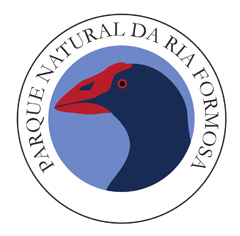Presentation
-
Any telegraphic description would simply say 2 peninsulas, 5 islands, 6 piers, marshlands and a scent of seawater. On the one side, the sea, on the other, before land, the estuary. The latter is located on Algarve's leeward between the sandy peninsulas of Ancão and Manta Rota to Ria Formosa, - The Natural Park occupies 18.400 ha - and is the most important wetland area on the south of Portugal, being separated from the sea by a cordon of barrier islands and fed in freshwater by small, seasonal water streams. Diverse habitats - dunes, marshlands, low tides, pine woods and agricultural areas - complete the set. Important area in terms of bird fauna and a varied marine fauna presence since the lagoon area works as a nursery to some marine species.
This Protected Area is stage for several activities - bivalve culture, fish farming, salt production, sand extraction... - and object of intensive visits being on the tourist heart of Algarve. Cacela-a-Velha with its 17th century fort, cubist Olhão or Tavira with its scissor roofs crossed by the Gilão / Séqua, live side by side with the characteristic agitation of the Algarve of leisure and summer.
-
Instituto da Conservação da Natureza e das Florestas, I.P. (ICNF, I.P.)
-
Estuaries and coastal lagoons
-
Algarve
-
Faro
Loulé
Olhão
Tavira
Vila Real de Santo António
Identification and Access
-
Access coming from:
- Faro - enter the barrier islands using the boats that leave Cais Comercial or Cais das Portas do Mar depending on the season, you can browse the schedules.
- Faro - access Faro beach, following the IC4/N125, and then the N125-10, heading towards Faro's Airport, in the Airport's roundabout follow the Praia de Faro Indication.
- Olhão - access the barrier islands using the tour boats that leave the boarding pier, browse the schedules.
- Tavira - enter Tavira's Island, where you have regular boat connections.
-
Yes
Tip
-
While you visit Barreta, Culatra, Armona, Tavira and Cabanas, the barrier islands that separate the estuary from the ocean, do not lose sight of the fragile balance of the whole system. Almost without showing, the estuary constantly changes shape. We recommend that you start your visit at the Interpretation Centre (Olhão), where you can find all the available information about the area.
To observe the fauna leave early in the morning or a bit before dusk. Bring binoculars and a camera, if you have them. Always pay attention to the weather forecast and avoid performing activities in days of rain, thunderstorm or fog. Avoid going out by yourself, but, if you do, inform an acquaintance or a local entity of your departure and return. Use simple and comfortable clothes. Make outerwear, food, water, sunscreen and/or a raincoat available. You may also want to take a cellphone and flashlight (do not start a fire and don't dispose of cigarette butts incorrectly). Take precautions and use insect repellent. If you want to enjoy the beaches do not forget your bathing suit. Take special precautions when walking in moist and rocky areas, to avoid falling and do not act in a way that might endanger yourself or others. In case of an accident contact the emergency service 112.
Supports in place
-
The Park has directional and informative signage throughout all of its area.
-
Yes
Walkways, ramps and adapted sanitary installations.
-
Yes
Activities and field trips for schools only by previous booking.
Statutes of Conservation
-
PTCON0013 Ria Formosa / Castro Marim
PTZPE0017 Ria Formosa
-
Ramsar Site Ria Formosa.
near you
-

From Montefigo hills (the top is the hill of San Miguel with 410 meters high) it is possible to see a good part of the eastern Algarve.
similar
Weather Conditions
What you can do
1. Scroll through Quinta do Ludo path, in early spring, and note the great diversity of birds.
2. Observe the flora and dunes vegetation, flowery and fragrant at this time of year, over Barril beach path at Tavira Island
3. Visit Tavira historic center of and the Fort of S. João da Barra in Cabanas.
1. In the morning, in Faro, take the boat to Barreta island, make the ria route and cool off at the beach area.
2. Visit the salt pans of Olhão and Tavira, during salt production.
3. Go to Santa Luzia, fishing village in the heart of the estuary, taste the traditional octopus dish and watch the sunset at the waterfront.
1. It is the time to go birdwatching. Make the route of Santa Luzia and Tavira saltterns and find there numerous species such as Black-winged Stilt, Pied Avocet, plovers, sandpipers, herons and flamingos.
2. Make the tour of the barrier islands, Culatra, Armona and Cabanas.
3. Stroll through Cacela-a-Velha, historic urban center of medieval origin where you can taste the shellfish produced in ria.
1. Discover S. Lourenço lagoon trail. This is a great time for birdwatching: large flocks (especially of waterfowls and waders) cross the skies and use the protected area.
2. Visit Centro de Educação Ambiental de Marim (Marim Environmental Education Center), at Quinta de Marim, in Olhão and meet the diversity of habitats and species along the footpath.
3. Set out to discover Olhão, the cubist village. Pay a visit to the fish and vegetable markets, with its simple architecture but monumental aspect.
Best Season: All year long
Parque Natural da Ria Formosa (Headquarters)
Centro de Educação Ambiental de Marim - Quelfes
8700-194 OLHÃO
Telephone: (00351) 289 700 210
E-mail: pnrf@icnf.pt







